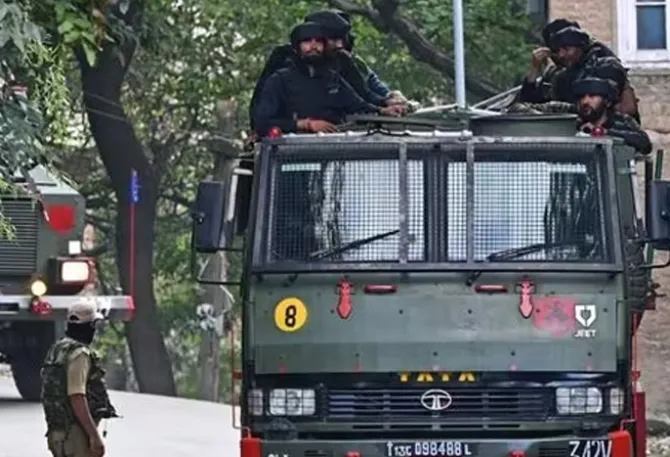-
CENTRES
Progammes & Centres
Location
The geography of terror groups is fluid. Kokernag to Kandahar is in the throes of security being provided by actors who were part of the crisis to begin with

The recent terror attack against India in Kashmir resulting in unacceptable casualties for the Indian Army was a reminder that despite a drop in the number of terror-related incidents over the years, the threat remains ever persistent.
Operations against terrorists in Kokernag, Anantnag, lasted for seven days. The act was claimed by The Resistance Front (TRF), a localised outfit acting as the “C team” of Lashkar-e-Taiba (LeT), raised in the time after the abrogation of Article 370 in 2019. Since then, the likes of TRF and its sister group, the People’s Anti-Fascist Front (PAFF), have recruited local Kashmiri youth, and their propaganda has included brandishing western-made weapons left behind by retreating United States (US)-led forces in Afghanistan.
The US in its Doha agreement with the Taliban largely kept its counterterrorism demands from the movement to the destruction of Al Qaeda.
The return of the Taliban in Kabul has galvanised both regional diplomacy and counter-terror narratives. For example, the Islamic Emirate’s interim foreign minister, Mawlawi Muttaqi, said the West was unable to even define “terrorism”. The US in its Doha agreement with the Taliban largely kept its counterterrorism demands from the movement to the destruction of Al Qaeda.
In a recent article, American columnist David Ignatius laid the claim that the Taliban has “all but extinguished Al Qaeda”. The argument was led by a view that while the Taliban may not have fully dismantled Al Qaeda, it has ended the latter’s international operations. In the same piece, it is also highlighted for the first time that the US shares “counterterror information” with the Taliban to use against Islamic State Khorasan Province (ISKP). This comes at the same time as former US CENTCOM chief General Frank McKenzie highlighted that the Taliban’s relations with Al Qaeda remain “far stronger” than those with the US. Often, American civil and military opinions on terrorism in Afghanistan diverge.
Counter-terrorism views in this region today do not speak in unity. US special representative for Afghanistan, Tom West, recently highlighted the successes of the Taliban in taking out top leaders of ISKP while also highlighting that the Tehrik-e-Taliban Pakistan (TTP) is now the “greatest threat” to regional stability. This narrative would mean that Pakistan will once again be in a position where it can negotiate with the West from the point of self-destructive leverage.
The Afghan Taliban has in essence refused to acknowledge the Durand Line, and the TTP has used this refusal as a cover to conduct regular attacks within Pakistani territory.
This new geographic belt, extending from Afghanistan to Kashmir, has two contested borders, which gives another dimension to ideological radicalisation in the region. The Afghan Taliban has in essence refused to acknowledge the Durand Line, and the TTP has used this refusal as a cover to conduct regular attacks within Pakistani territory. Even though a Doha-style negotiation outreach was attempted in 2022 between the TTP and Pakistan, it failed because of the wide gap in demands and expectations between the two, and because the mediator, the Afghan Taliban, did not want to pick sides.
The Taliban has repeated its assertions that it would not allow Afghanistan’s territories to be used to conduct attacks against other States. As shown above, it has gained some support from its one-time foe in the US. Even Iran’s intelligence chief, Sayeed Esmail Khatib, has expressed satisfaction at the cooperation received from the Taliban in counterterror matters.
The geography of terror groups is fluid. From Kokernag to Kandahar, this belt of land is in the throes of security being provided by actors who were part of the crisis to begin with. The Taliban actively taking on and limiting ISKP is first and foremost an interest of the Taliban itself. ISKP has actively targeted the Taliban’s rule. ISKP regularly releases propaganda material online against the Taliban, including its outreach to neighbouring States such as India, China, and Iran.
The Taliban actively taking on and limiting ISKP is first and foremost an interest of the Taliban itself.
The Taliban can secure its interest while simultaneously doing so for others in the region as well. However, all these recent events are based around two entities, ISKP and Al Qaeda. Others such as LeT, Jaish-e-Mohammed and so on remain unmentioned. Even as the irony of TTP challenging the Pakistani State sets in, New Delhi must remain vigilant.
This commentary originally appeared in Hindustan Times.
The views expressed above belong to the author(s). ORF research and analyses now available on Telegram! Click here to access our curated content — blogs, longforms and interviews.

Kabir Taneja is a Deputy Director and Fellow, Middle East, with the Strategic Studies programme. His research focuses on India’s relations with the Middle East ...
Read More +